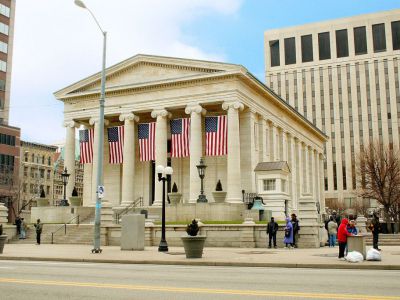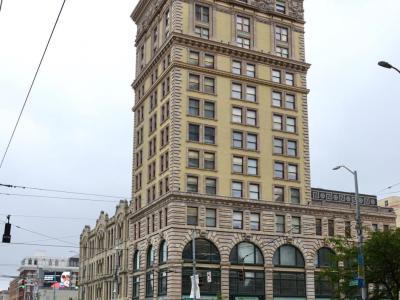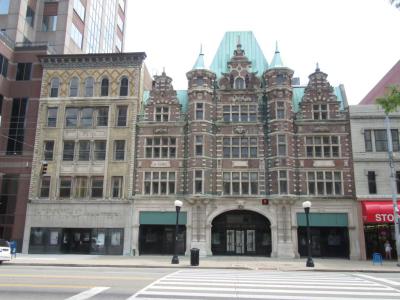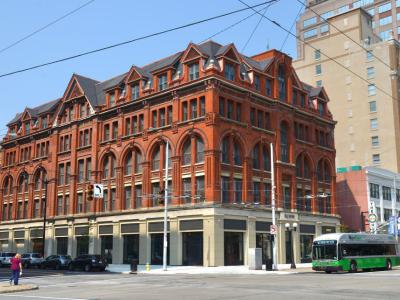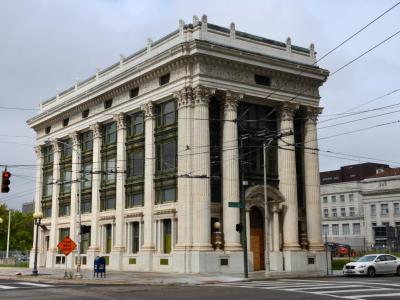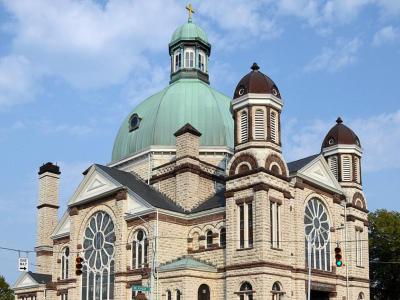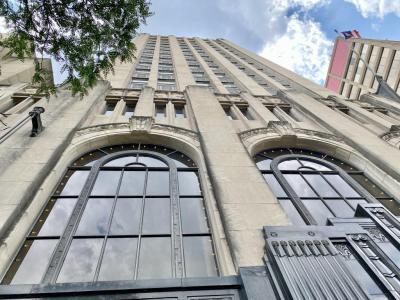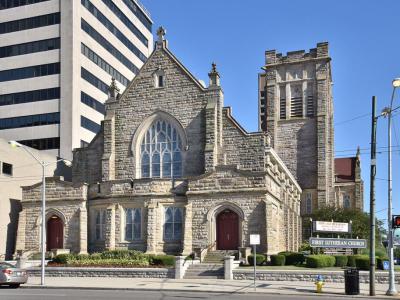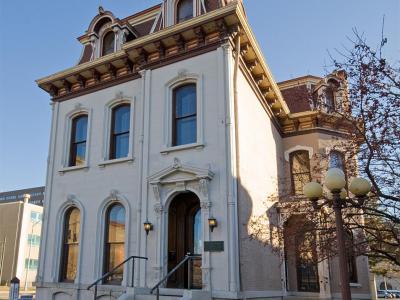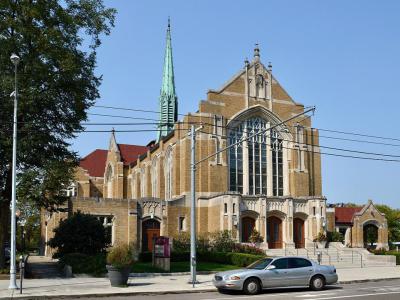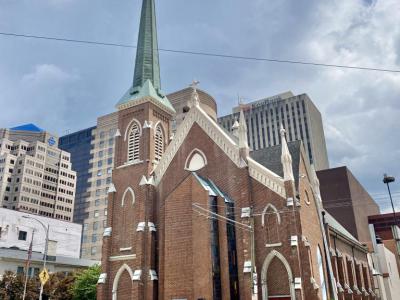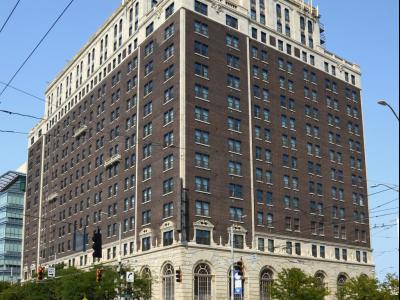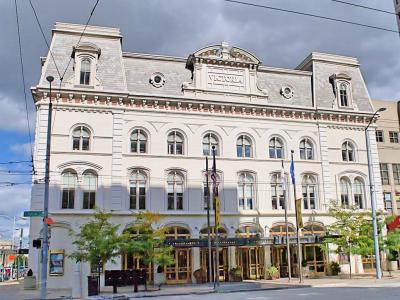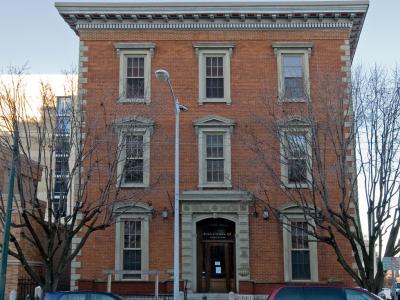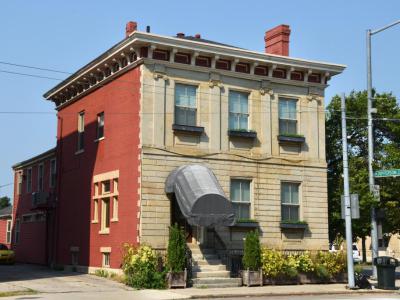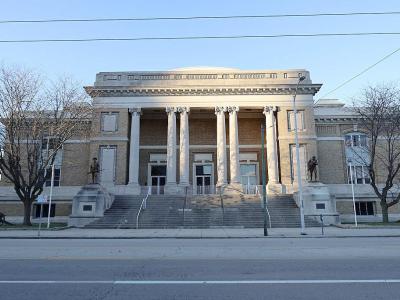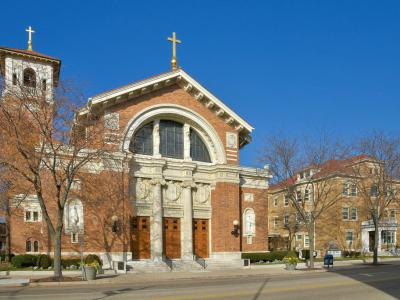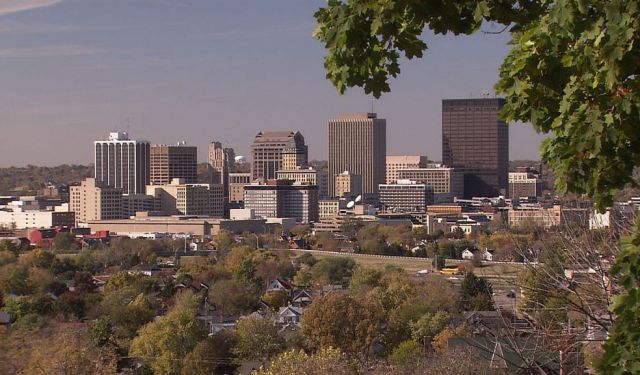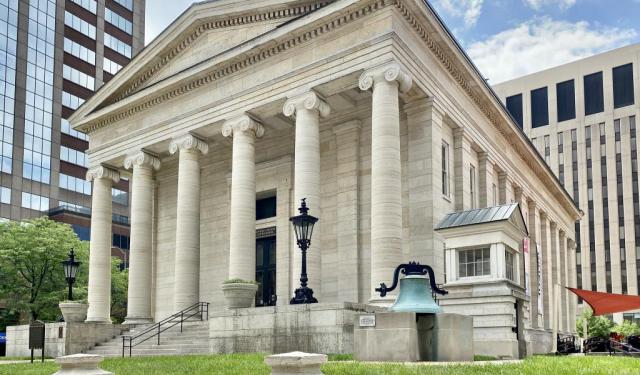
Dayton Historical Buildings Tour (Self Guided), Dayton
Dayton, Ohio, is home to a number of impressive historical buildings designed in a variety of styles, many of which are listed in the National Register of Historic Places.
One such is the Montgomery County Courthouse. Constructed in 1847, it exemplifies the Greek Revival style with its imposing columns and classical facades. Nearby, the Conover Building, dating back to 1900, showcases Eclectic Renaissance architecture, drawing inspiration from a wide range of classicizing Italian modes.
The Dayton Arcade, built in 1904, is a masterpiece of Victorian Gothic style, featuring intricate stonework and large, arched windows.
The Benjamin F Kuhns Building, completed in 1883, is an elegant example of Romanesque Revival, known for its more simplified (compared to their historic counterparts) arches and windows.
The Dayton Daily News Building, erected in 1908, represents early 20th-century commercial architecture, featuring Corinthian and Doric columns, a grand entrance frontispiece, and a distinctive partial pediment with cornucopiae-supported cornice.
Liberty Tower, constructed in 1931, is a notable Art Deco skyscraper, symbolizing Dayton's modernist aspirations during the early 20th century.
The Isaac Pollack House, built in 1876, is a Second Empire-style residence later repurposed as the Dayton International Peace Museum.
The Dayton Biltmore Hotel, opened in 1929, is a Beaux-Arts gem, known for its applied masonry façade, resulting in a striking dark brown and white exterior.
These and other architectural landmarks enrich the community's identity and offer glimpses into its past. Exploring them fosters a deeper appreciation for the craftsmanship and creativity of those who built and designed them. Our self-guided walk offers you an opportunity to connect with the architectural evolution of Dayton.
One such is the Montgomery County Courthouse. Constructed in 1847, it exemplifies the Greek Revival style with its imposing columns and classical facades. Nearby, the Conover Building, dating back to 1900, showcases Eclectic Renaissance architecture, drawing inspiration from a wide range of classicizing Italian modes.
The Dayton Arcade, built in 1904, is a masterpiece of Victorian Gothic style, featuring intricate stonework and large, arched windows.
The Benjamin F Kuhns Building, completed in 1883, is an elegant example of Romanesque Revival, known for its more simplified (compared to their historic counterparts) arches and windows.
The Dayton Daily News Building, erected in 1908, represents early 20th-century commercial architecture, featuring Corinthian and Doric columns, a grand entrance frontispiece, and a distinctive partial pediment with cornucopiae-supported cornice.
Liberty Tower, constructed in 1931, is a notable Art Deco skyscraper, symbolizing Dayton's modernist aspirations during the early 20th century.
The Isaac Pollack House, built in 1876, is a Second Empire-style residence later repurposed as the Dayton International Peace Museum.
The Dayton Biltmore Hotel, opened in 1929, is a Beaux-Arts gem, known for its applied masonry façade, resulting in a striking dark brown and white exterior.
These and other architectural landmarks enrich the community's identity and offer glimpses into its past. Exploring them fosters a deeper appreciation for the craftsmanship and creativity of those who built and designed them. Our self-guided walk offers you an opportunity to connect with the architectural evolution of Dayton.
How it works: Download the app "GPSmyCity: Walks in 1K+ Cities" from Apple App Store or Google Play Store to your mobile phone or tablet. The app turns your mobile device into a personal tour guide and its built-in GPS navigation functions guide you from one tour stop to next. The app works offline, so no data plan is needed when traveling abroad.
Dayton Historical Buildings Tour Map
Guide Name: Dayton Historical Buildings Tour
Guide Location: USA » Dayton (See other walking tours in Dayton)
Guide Type: Self-guided Walking Tour (Sightseeing)
# of Attractions: 18
Tour Duration: 3 Hour(s)
Travel Distance: 3.0 Km or 1.9 Miles
Author: sabrina
Sight(s) Featured in This Guide:
Guide Location: USA » Dayton (See other walking tours in Dayton)
Guide Type: Self-guided Walking Tour (Sightseeing)
# of Attractions: 18
Tour Duration: 3 Hour(s)
Travel Distance: 3.0 Km or 1.9 Miles
Author: sabrina
Sight(s) Featured in This Guide:
- Montgomery County Courthouse
- Conover Building
- Dayton Arcade
- Benjamin F. Kuhns Building
- Dayton Daily News Building
- Sacred Heart Church
- Liberty Tower
- Westminster Presbyterian Church
- First Lutheran Church
- Isaac Pollack House
- First Baptist Church
- Christ Episcopal Church
- The Dayton Biltmore Hotel
- Victoria Theatre
- Dr. Jefferson A. Walters House
- James Brooks House
- Dayton Memorial Hall
- St. Joseph Parish Church
1) Montgomery County Courthouse
The Montgomery County Courthouse stands as a remarkable example of Greek Revival architecture in the United States. Built in 1847, this historic limestone building is located at the prominent intersection of Third and Main streets. Its design draws inspiration from the Temple of Hephaestus in Athens, Greece, a structure dating back to the 5th century BC, known for its Doric order and classical simplicity.
The architectural plan of the Montgomery County Courthouse mirrors the traditional Greek temple layout, featuring a high-ceiling vestibule leading to a center hall that culminates in a grand rotunda and elliptical courtroom. This layout not only pays homage to ancient Greek architectural principles but also provides a dignified and imposing setting appropriate for a courthouse.
The courthouse's design was influenced by Dayton citizen Horace Pease, who advocated for using the Temple of Theseus in Athens as a model. The Montgomery County Commissioners agreed with Pease's suggestion and commissioned architect Howard Daniels of New York to draw up the plans. Daniels successfully captured the essence and aesthetic beauty of the ancient Greek temple, resulting in a structure that remains a pinnacle of Greek Revival style in American architecture.
Recognized for its historical and architectural significance, the Montgomery County Courthouse was added to the National Register of Historic Places on January 26, 1970.
The architectural plan of the Montgomery County Courthouse mirrors the traditional Greek temple layout, featuring a high-ceiling vestibule leading to a center hall that culminates in a grand rotunda and elliptical courtroom. This layout not only pays homage to ancient Greek architectural principles but also provides a dignified and imposing setting appropriate for a courthouse.
The courthouse's design was influenced by Dayton citizen Horace Pease, who advocated for using the Temple of Theseus in Athens as a model. The Montgomery County Commissioners agreed with Pease's suggestion and commissioned architect Howard Daniels of New York to draw up the plans. Daniels successfully captured the essence and aesthetic beauty of the ancient Greek temple, resulting in a structure that remains a pinnacle of Greek Revival style in American architecture.
Recognized for its historical and architectural significance, the Montgomery County Courthouse was added to the National Register of Historic Places on January 26, 1970.
2) Conover Building
The Conover Building, also known as Wright Stop Plaza, is a historic structure prominently located in downtown Dayton. Constructed at the turn of the twentieth century, this thirteen-story building is a testament to architectural diversity, incorporating elements from multiple sub-styles of Neo-Renaissance architecture, along with occasional Neoclassical details. The building’s exterior features a blend of brick and stone, complemented by terra cotta accents for peripheral detailing, while its supporting structure utilizes concrete and steel. Designed by the renowned architect Frank Mills Andrews, the Conover Building reflects his widespread acclaim and influence in American architecture.
Situated at a key intersection, the Conover Building’s design is marked by a mix of architectural styles that contribute to its distinctive appearance. The bottom four stories exhibit a traditional commercial design with an arcade, providing a functional and aesthetically pleasing space for businesses. The top three stories are adorned with Baroque styling, adding a layer of ornate detail that contrasts with the plainer middle six stories. These middle stories are notable for their trabeated design at the summit, offering a visual transition between the building's base and its decorative upper floors.
Erected just eight years after Dayton’s first skyscraper, the Conover Building holds a significant place in the city’s architectural history. In recognition of its architectural significance and historical importance, the Conover Building was listed on the National Register of Historic Places in 1975.
Situated at a key intersection, the Conover Building’s design is marked by a mix of architectural styles that contribute to its distinctive appearance. The bottom four stories exhibit a traditional commercial design with an arcade, providing a functional and aesthetically pleasing space for businesses. The top three stories are adorned with Baroque styling, adding a layer of ornate detail that contrasts with the plainer middle six stories. These middle stories are notable for their trabeated design at the summit, offering a visual transition between the building's base and its decorative upper floors.
Erected just eight years after Dayton’s first skyscraper, the Conover Building holds a significant place in the city’s architectural history. In recognition of its architectural significance and historical importance, the Conover Building was listed on the National Register of Historic Places in 1975.
3) Dayton Arcade
The Dayton Arcade is a historic and architecturally significant complex situated in the heart of Dayton. Comprising nine interconnected buildings, the Arcade was constructed between 1902 and 1904. The visionary behind this project was Eugene J. Barney of the Barney & Smith Car Company, who aimed to create a state-of-the-art facility equipped with the latest innovations of the time, such as elevators, a power plant, and a cold-storage plant. The design of the Arcade was entrusted to architect Frank M. Andrews, who also designed many of NCR's factory buildings and the American Building at Third and Main Streets in Dayton.
A standout feature of the Dayton Arcade is its glass-domed rotunda, which measures 70 feet in height and 90 feet in diameter. This impressive structure is adorned with detailed carvings that celebrate Ohio's natural and agricultural heritage, including oak leaves, acorns, grains, ram heads, wild turkeys, and cornucopias filled with local produce. The rotunda is encircled by two balconied upper floors that overlook the central enclave, creating a grand and open interior space.
The great dome is perhaps the most intriguing architectural feature of the Dayton Arcade. Unlike traditional rotundas with classical detailing, this dome incorporates elements that reflect Ohio's identity. The decorative elements include colorful turkeys, festoons of oak leaves and acorns, and garlands of grain, all emphasizing the state's rich natural and agricultural resources.
The Arcade's architectural style varies across its different facades. The most notable building fronts are on Third Street, designed in the Flemish façade style, reportedly inspired by a guildhall in Amsterdam, Netherlands, and featuring old Dutch architectural elements. In contrast, the facades on Fourth Street and Ludlow Street are rendered in the Italian Renaissance Revival style, with the Commercial Building prominently anchoring the corner of the lot. This blend of architectural styles contributes to the complex's unique and historically rich character.
A standout feature of the Dayton Arcade is its glass-domed rotunda, which measures 70 feet in height and 90 feet in diameter. This impressive structure is adorned with detailed carvings that celebrate Ohio's natural and agricultural heritage, including oak leaves, acorns, grains, ram heads, wild turkeys, and cornucopias filled with local produce. The rotunda is encircled by two balconied upper floors that overlook the central enclave, creating a grand and open interior space.
The great dome is perhaps the most intriguing architectural feature of the Dayton Arcade. Unlike traditional rotundas with classical detailing, this dome incorporates elements that reflect Ohio's identity. The decorative elements include colorful turkeys, festoons of oak leaves and acorns, and garlands of grain, all emphasizing the state's rich natural and agricultural resources.
The Arcade's architectural style varies across its different facades. The most notable building fronts are on Third Street, designed in the Flemish façade style, reportedly inspired by a guildhall in Amsterdam, Netherlands, and featuring old Dutch architectural elements. In contrast, the facades on Fourth Street and Ludlow Street are rendered in the Italian Renaissance Revival style, with the Commercial Building prominently anchoring the corner of the lot. This blend of architectural styles contributes to the complex's unique and historically rich character.
4) Benjamin F. Kuhns Building
The Benjamin F. Kuhns Building stands out for its well-preserved late nineteenth-century architecture, which led to its designation as a historic site. This Romanesque Revival building, constructed of brick with a slate roof, incorporates elements of stone and terracotta. Its distinctive facade is divided into five bays, each featuring a large arch, and the street-facing southern side mirrors this design on a larger scale. Designed by the Dayton-based architectural firm Peters and Burns, and constructed by local contractors Beaver and Butt, the building is an architectural gem of its era.
Throughout its early years, the Benjamin F. Kuhns Building housed various commercial enterprises. The Manhattan Clothing Store and Oleman's Department Store were notable tenants during the 1890s and 1910s, respectively. Interestingly, the building also served educational purposes, hosting an arts school during the 1888-1889 school year. Among its interior features is a historically significant mail chute, reputed to be one of the earliest installed in any building nationwide, adding a unique element to its rich history.
The building's namesake, Benjamin Kuhns, moved from Lancaster, Pennsylvania, to Dayton in 1855 at the age of thirty. By his fiftieth birthday, Kuhns had become a prominent industrialist, transforming a small Dayton firm into a leading manufacturer of agricultural equipment. Besides his business acumen, Kuhns was a noted philanthropist, playing a crucial role in founding Miami Valley Hospital, a testament to his commitment to community welfare.
In recognition of its historical and architectural significance, the Benjamin F. Kuhns Building was listed on the National Register of Historic Places in April 1978.
Throughout its early years, the Benjamin F. Kuhns Building housed various commercial enterprises. The Manhattan Clothing Store and Oleman's Department Store were notable tenants during the 1890s and 1910s, respectively. Interestingly, the building also served educational purposes, hosting an arts school during the 1888-1889 school year. Among its interior features is a historically significant mail chute, reputed to be one of the earliest installed in any building nationwide, adding a unique element to its rich history.
The building's namesake, Benjamin Kuhns, moved from Lancaster, Pennsylvania, to Dayton in 1855 at the age of thirty. By his fiftieth birthday, Kuhns had become a prominent industrialist, transforming a small Dayton firm into a leading manufacturer of agricultural equipment. Besides his business acumen, Kuhns was a noted philanthropist, playing a crucial role in founding Miami Valley Hospital, a testament to his commitment to community welfare.
In recognition of its historical and architectural significance, the Benjamin F. Kuhns Building was listed on the National Register of Historic Places in April 1978.
5) Dayton Daily News Building
The Dayton Daily News Building is a historic structure designed by architect Albert Pretzinger for James M. Cox, the founder of the Dayton Daily News. Cox's motivation for establishing the newspaper came after a local banker refused him a loan, citing the historical unprofitability of newspapers. In response, Cox commissioned Pretzinger to "build him a damn bank," resulting in a design modeled after the Knickerbocker Trust building in New York City. This unique inspiration gave the building its distinctive architectural features, which include a three-bay-wide facade adorned with Corinthian and Doric columns, a grand frontispiece around the entrance, and a partial pediment with a cornice supported by cornucopiae.
Constructed between 1908 and 1910, the Dayton Daily News Building was built using a combination of wood and granite. Over the decades, it underwent several expansions in the 1920s, 1950s, and 1970s to accommodate the growing needs of the newspaper. Despite these additions, the core of the 1908 structure remained intact. In 1989, the original building received a significant remodel, further preserving its historical integrity. The building's architectural significance and historical value were recognized when it was added to the National Register of Historic Places on November 30, 1978.
The Dayton Daily News relocated its editorial and business offices in April 2007 to the former NCR Building 31, situated at 1611 S. Main St. near the University of Dayton campus. This move marked a new chapter for the newspaper while preserving its historical roots. However, the newer portions of the Dayton Daily News building were demolished in 2013, leaving only the original 1908 structure on the corner. As part of this demolition process, the nearby Schwind Building at 27 Ludlow, built in 1913, was imploded on August 17, 2013.
Constructed between 1908 and 1910, the Dayton Daily News Building was built using a combination of wood and granite. Over the decades, it underwent several expansions in the 1920s, 1950s, and 1970s to accommodate the growing needs of the newspaper. Despite these additions, the core of the 1908 structure remained intact. In 1989, the original building received a significant remodel, further preserving its historical integrity. The building's architectural significance and historical value were recognized when it was added to the National Register of Historic Places on November 30, 1978.
The Dayton Daily News relocated its editorial and business offices in April 2007 to the former NCR Building 31, situated at 1611 S. Main St. near the University of Dayton campus. This move marked a new chapter for the newspaper while preserving its historical roots. However, the newer portions of the Dayton Daily News building were demolished in 2013, leaving only the original 1908 structure on the corner. As part of this demolition process, the nearby Schwind Building at 27 Ludlow, built in 1913, was imploded on August 17, 2013.
6) Sacred Heart Church
Built in 1888 by the renowned local architect Charles Insco Williams, the Sacred Heart Catholic Church was initially established to serve a burgeoning parish community. Over the years, its striking architectural features have cemented its status as a significant historical site. Although it ceased regular operations in 1996, the church found new life in 2001 when a Vietnamese Catholic group began using the facility, revitalizing its role in the community.
The architectural grandeur of Sacred Heart Church is one of its most compelling attributes. The structure showcases an intricate blend of Romanesque and Queen Anne styles, characterized by its majestic stained-glass windows and an imposing octagonal Baroque dome topped with a glazed cupola. The church's exterior is constructed from locally quarried limestone and Berea sandstone, enhancing its historic and regional significance. Towers flanking the main entrance and rose windows beneath the pediments further accentuate the church's architectural elegance.
Despite suffering significant damage during the Great Flood of 1913, which destroyed much of its original grand woodworking, artwork, and chandeliers, Sacred Heart Church has retained its historical essence. Over the years, various elements were either removed or painted over, yet the core structure and design continue to reflect the church's storied past. The church's resilience and enduring beauty have earned it a place on the National Register of Historic Places, a designation it received in 1988.
The architectural grandeur of Sacred Heart Church is one of its most compelling attributes. The structure showcases an intricate blend of Romanesque and Queen Anne styles, characterized by its majestic stained-glass windows and an imposing octagonal Baroque dome topped with a glazed cupola. The church's exterior is constructed from locally quarried limestone and Berea sandstone, enhancing its historic and regional significance. Towers flanking the main entrance and rose windows beneath the pediments further accentuate the church's architectural elegance.
Despite suffering significant damage during the Great Flood of 1913, which destroyed much of its original grand woodworking, artwork, and chandeliers, Sacred Heart Church has retained its historical essence. Over the years, various elements were either removed or painted over, yet the core structure and design continue to reflect the church's storied past. The church's resilience and enduring beauty have earned it a place on the National Register of Historic Places, a designation it received in 1988.
7) Liberty Tower
Liberty Tower has been a prominent fixture for local businesses, entrepreneurs, and community leaders since its construction in the 1930s. Originally known as the Mutual Home Savings Association Building, it was the tallest building in Dayton from its completion in 1931 until 1969.
The tower has undergone several name changes, becoming the Hulman Building in 1949 after being acquired by the Hulman family, owners of the Indianapolis Motor Speedway, and later renamed Liberty Tower in 1998 after Liberty Savings Bank. Currently, it hosts a branch of First Financial Bank, following the acquisition of numerous Liberty Savings Bank locations. In 1982, Liberty Tower was listed on the National Register of Historic Places, cementing its status as a historic landmark.
The Mutual Home Savings Building was an architectural marvel at the time of its construction, boasting an impressive 20 floors and becoming Dayton’s first skyscraper. It remains Dayton’s sole example of Art Deco architecture, a style celebrated for its bold geometric forms and lavish ornamentation, reminiscent of iconic structures like the Empire State Building and the Chrysler Building.
The interior of Liberty Tower is a testament to this aesthetic, featuring intricate Art Deco designs. The newly renovated events space on the first floor, The Grande Hall at Liberty Tower, showcases breathtaking Italian marble walls and Tennessee marble floors, exemplifying the symmetrical beauty characteristic of the Art Deco movement.
During World War II, Liberty Tower served a crucial role as the headquarters for the Army Signal Corps. The building's roof was utilized as an observation deck, with two watchmen stationed 24/7 to patrol the airspace and monitor Wright-Patterson Air Force Base, which is still visible from the roof on clear days. This wartime use added to the building's historical significance, highlighting its strategic importance during a critical period in American history.
The tower has undergone several name changes, becoming the Hulman Building in 1949 after being acquired by the Hulman family, owners of the Indianapolis Motor Speedway, and later renamed Liberty Tower in 1998 after Liberty Savings Bank. Currently, it hosts a branch of First Financial Bank, following the acquisition of numerous Liberty Savings Bank locations. In 1982, Liberty Tower was listed on the National Register of Historic Places, cementing its status as a historic landmark.
The Mutual Home Savings Building was an architectural marvel at the time of its construction, boasting an impressive 20 floors and becoming Dayton’s first skyscraper. It remains Dayton’s sole example of Art Deco architecture, a style celebrated for its bold geometric forms and lavish ornamentation, reminiscent of iconic structures like the Empire State Building and the Chrysler Building.
The interior of Liberty Tower is a testament to this aesthetic, featuring intricate Art Deco designs. The newly renovated events space on the first floor, The Grande Hall at Liberty Tower, showcases breathtaking Italian marble walls and Tennessee marble floors, exemplifying the symmetrical beauty characteristic of the Art Deco movement.
During World War II, Liberty Tower served a crucial role as the headquarters for the Army Signal Corps. The building's roof was utilized as an observation deck, with two watchmen stationed 24/7 to patrol the airspace and monitor Wright-Patterson Air Force Base, which is still visible from the roof on clear days. This wartime use added to the building's historical significance, highlighting its strategic importance during a critical period in American history.
8) Westminster Presbyterian Church
Built in 1926, the Westminster Presbyterian Church is renowned for its stunning Neo-Gothic design crafted by the distinguished architect Ralph Adams. The sanctuary's grandeur is a key feature, providing a spiritually enriching environment with its beautifully decorated interior.
The main hall of Westminster Presbyterian Church is a marvel of Neo-Gothic architecture, characterized by intricate stained glass windows that filter colorful light into the space, creating a serene and contemplative atmosphere. The wooden ceiling beams and columns add a rustic charm, while the chandeliers cast a warm glow, enhancing the sanctuary's majestic ambiance. The illuminated altar serves as a focal point, drawing the eyes upward to the impressive high ceiling, which contributes to the hall's sense of expansiveness and reverence.
In addition to the sanctuary, the church complex includes a wooden chapel, numerous classrooms, a children’s room, and a library, catering to the diverse needs of its congregation. The chapel provides a more intimate setting for worship and reflection, while the classrooms support educational and community activities, reflecting the church's commitment to fostering spiritual growth and learning. The children’s room offers a welcoming space for the youngest members, ensuring that families feel included and supported.
The main hall of Westminster Presbyterian Church is a marvel of Neo-Gothic architecture, characterized by intricate stained glass windows that filter colorful light into the space, creating a serene and contemplative atmosphere. The wooden ceiling beams and columns add a rustic charm, while the chandeliers cast a warm glow, enhancing the sanctuary's majestic ambiance. The illuminated altar serves as a focal point, drawing the eyes upward to the impressive high ceiling, which contributes to the hall's sense of expansiveness and reverence.
In addition to the sanctuary, the church complex includes a wooden chapel, numerous classrooms, a children’s room, and a library, catering to the diverse needs of its congregation. The chapel provides a more intimate setting for worship and reflection, while the classrooms support educational and community activities, reflecting the church's commitment to fostering spiritual growth and learning. The children’s room offers a welcoming space for the youngest members, ensuring that families feel included and supported.
9) First Lutheran Church
First Lutheran Church is renowned for its impressive Gothic Revival architecture. Established in the early 1900s to accommodate a large congregation, this church has been recognized as a historic site due to its architectural significance and enduring legacy. The congregation's roots date back to 1841, just two years after its organization, with the construction of its initial two-story building. This original building took over a year to be ready for worship, with the second story being added three years later.
The current church building, completed in 1906, showcases a Gothic Revival style designed by the architectural firm of Peters, Burns, and Pretzinger. The architects aimed to emulate the grandeur of prominent Lutheran churches in Europe, incorporating various traditional elements into the design. These include stained glass portraits of the Twelve Apostles and the Four Evangelists, intricate label stops with figureheads, and a painted ceiling with visible structural components. These features combine to create a visually stunning and spiritually uplifting worship space.
One of the church's most striking features is its central tower, which rises to a height of 100 feet (30 meters). This tower, along with the tall, thin ogive windows and the use of stone with multicolored veins for the exterior walls, contributes to the building's distinctive Gothic Revival aesthetic. The rusticated stone construction adds a sense of permanence and strength, reflecting the church's historical and cultural significance within the community.
As the only remaining downtown church in Dayton built in the Gothic Revival style, First Lutheran Church stands as a testament to the city's rich architectural heritage.
The current church building, completed in 1906, showcases a Gothic Revival style designed by the architectural firm of Peters, Burns, and Pretzinger. The architects aimed to emulate the grandeur of prominent Lutheran churches in Europe, incorporating various traditional elements into the design. These include stained glass portraits of the Twelve Apostles and the Four Evangelists, intricate label stops with figureheads, and a painted ceiling with visible structural components. These features combine to create a visually stunning and spiritually uplifting worship space.
One of the church's most striking features is its central tower, which rises to a height of 100 feet (30 meters). This tower, along with the tall, thin ogive windows and the use of stone with multicolored veins for the exterior walls, contributes to the building's distinctive Gothic Revival aesthetic. The rusticated stone construction adds a sense of permanence and strength, reflecting the church's historical and cultural significance within the community.
As the only remaining downtown church in Dayton built in the Gothic Revival style, First Lutheran Church stands as a testament to the city's rich architectural heritage.
10) Isaac Pollack House
The Isaac Pollack House was originally built in 1876. This Second Empire-style house was the residence of Isaac Pollack, a notable Dayton businessman known for his involvement in the liqueur trade. The building is characterized by its mixed construction of stone and brick with wooden elements, resting on a sturdy stone foundation and topped with a slate roof.
In 1913, the house transitioned from a residential property when Fenton T. Bott acquired it. Bott used the house for his Bott Dancing Academy, where he also lived until 1941. Following Bott’s tenure, the Montgomery County Board of Elections used the property as their offices for twenty years, beginning in 1956. In 1979, the house was relocated from its original site at 319 West Third Street to its current location at the intersection of Wilkinson Street and Monument Avenue, on the northern edge of downtown Dayton, near the Great Miami River and close to Interstate 75.
From October 14, 2005, to September 2021, the Isaac Pollack House served as the home of the Dayton International Peace Museum. This period marked another chapter in the building's adaptive reuse, contributing to the cultural and social fabric of the community. Its architectural significance and historical relevance, being the residence of a prominent local citizen, led to its listing on the National Register of Historic Places on December 11, 1974.
In 1913, the house transitioned from a residential property when Fenton T. Bott acquired it. Bott used the house for his Bott Dancing Academy, where he also lived until 1941. Following Bott’s tenure, the Montgomery County Board of Elections used the property as their offices for twenty years, beginning in 1956. In 1979, the house was relocated from its original site at 319 West Third Street to its current location at the intersection of Wilkinson Street and Monument Avenue, on the northern edge of downtown Dayton, near the Great Miami River and close to Interstate 75.
From October 14, 2005, to September 2021, the Isaac Pollack House served as the home of the Dayton International Peace Museum. This period marked another chapter in the building's adaptive reuse, contributing to the cultural and social fabric of the community. Its architectural significance and historical relevance, being the residence of a prominent local citizen, led to its listing on the National Register of Historic Places on December 11, 1974.
11) First Baptist Church
First Baptist Church has a rich history dating back to its organization on May 29, 1824. Its origins trace to a small group that met on the porch of William Huffman's home, where they were formally approved as a congregation with nine members. The following day marked a significant event in Dayton's Baptist history when Lydia Huffman was baptized in the Great Miami River, marking the city's first recorded Baptist immersion.
The church's first building was erected in 1827 on Main Street, but the congregation faced challenges in 1829 with a schism that led to a split. Those remaining steadfast in their Baptist beliefs incorporated as The First Regular Baptist Church of Dayton in 1837. Over the decades, the church played a pivotal role in the community, attracting prominent local families and becoming a center for spiritual and civic engagement.
In 1914, amidst the challenges posed by the devastating 1913 Dayton flood, construction began on the current Monument Avenue building. Completed and furnished by June 1915, this building has since served as a cornerstone for the congregation's activities and outreach. Noteworthy figures from Dayton's history, such as Orville Wright, had connections to the church, with Wright's funeral being hosted there in 1948 due to his niece's involvement in the congregation.
The church's first building was erected in 1827 on Main Street, but the congregation faced challenges in 1829 with a schism that led to a split. Those remaining steadfast in their Baptist beliefs incorporated as The First Regular Baptist Church of Dayton in 1837. Over the decades, the church played a pivotal role in the community, attracting prominent local families and becoming a center for spiritual and civic engagement.
In 1914, amidst the challenges posed by the devastating 1913 Dayton flood, construction began on the current Monument Avenue building. Completed and furnished by June 1915, this building has since served as a cornerstone for the congregation's activities and outreach. Noteworthy figures from Dayton's history, such as Orville Wright, had connections to the church, with Wright's funeral being hosted there in 1948 due to his niece's involvement in the congregation.
12) Christ Episcopal Church
Christ Episcopal Church has been a significant religious institution since its founding in 1830. The church was established through the efforts of Bishop Philander Chase, who invited Ethan Allen to Ohio to engage in missionary work. Originally situated elsewhere, the congregation moved to its current location in 1879. This relocation marked the beginning of a new chapter for Christ Episcopal Church, cementing its place in the heart of the community.
The church building is a quintessential example of Gothic Revival architecture, featuring a magnificent tower at the front entrance that captures the eye of all who pass by. This architectural style, known for its pointed arches, ribbed vaults, and flying buttresses, imbues the structure with an air of historical significance and spiritual grandeur
In 1913, Christ Episcopal Church faced a significant challenge when the Great Flood inundated its basement. This disaster necessitated a full renovation of the affected areas, ensuring the building could continue to serve its congregation. By November 1967, the church had reopened to the public, restored and ready to continue its mission of faith and service.
The church building is a quintessential example of Gothic Revival architecture, featuring a magnificent tower at the front entrance that captures the eye of all who pass by. This architectural style, known for its pointed arches, ribbed vaults, and flying buttresses, imbues the structure with an air of historical significance and spiritual grandeur
In 1913, Christ Episcopal Church faced a significant challenge when the Great Flood inundated its basement. This disaster necessitated a full renovation of the affected areas, ensuring the building could continue to serve its congregation. By November 1967, the church had reopened to the public, restored and ready to continue its mission of faith and service.
13) The Dayton Biltmore Hotel
The Dayton Biltmore Hotel opened its doors on November 16, 1929. Designed by architect Frederick Hughes of F.J. Hughes and Company, the Biltmore showcases the Beaux-Arts style, characterized by its applied masonry façade system that combines brick and terra cotta, resulting in a striking dark brown and white exterior. Hughes, who also designed the nearby Commodore Apartments and Centre City Building, imbued the Biltmore with the same architectural elegance. Upon its completion, the Biltmore quickly gained a reputation as one of America's finest hotels, hosting notable figures such as John F. Kennedy and Elvis Presley.
Originally operated by Bowman-Biltmore Hotels, the Dayton Biltmore was acquired by Hilton Hotels in 1946. In March 1965, the hotel was rebranded as the Sheraton-Dayton Hotel under the Sheraton chain, but in 1974, it transitioned once more to become the Biltmore Towers Hotel. By 1981, the Kuhlmann Design Group had redeveloped the historic property into housing for the elderly, reflecting the building's ability to adapt to the changing needs of the community. The Biltmore's historical and architectural significance was recognized on February 3, 1982, when it was listed on the National Register of Historic Places.
Standing eighteen stories tall, the Dayton Biltmore has seen numerous renovations, with the most recent significant overhaul occurring in 1981. This redevelopment transformed the former luxury hotel into Biltmore Towers, which today comprises 230 apartments. Despite its transformation, the building retains seven retail spaces on its premises, contributing to the vibrant urban fabric of downtown Dayton. Among the current business tenants are China Royal Restaurant and Jimmy John’s, maintaining the building's legacy as a bustling hub in the heart of the city.
Originally operated by Bowman-Biltmore Hotels, the Dayton Biltmore was acquired by Hilton Hotels in 1946. In March 1965, the hotel was rebranded as the Sheraton-Dayton Hotel under the Sheraton chain, but in 1974, it transitioned once more to become the Biltmore Towers Hotel. By 1981, the Kuhlmann Design Group had redeveloped the historic property into housing for the elderly, reflecting the building's ability to adapt to the changing needs of the community. The Biltmore's historical and architectural significance was recognized on February 3, 1982, when it was listed on the National Register of Historic Places.
Standing eighteen stories tall, the Dayton Biltmore has seen numerous renovations, with the most recent significant overhaul occurring in 1981. This redevelopment transformed the former luxury hotel into Biltmore Towers, which today comprises 230 apartments. Despite its transformation, the building retains seven retail spaces on its premises, contributing to the vibrant urban fabric of downtown Dayton. Among the current business tenants are China Royal Restaurant and Jimmy John’s, maintaining the building's legacy as a bustling hub in the heart of the city.
14) Victoria Theatre
The Victoria Theatre is a testament to resilience and cultural prominence, tracing its origins back to its opening on January 1, 1866, as the Turner Opera House. This historic venue quickly became a centerpiece of Dayton's cultural scene, hosting renowned performers such as Edwin Forrest, Lillie Langtry, Harry Houdini, Sarah Bernhardt, and Mark Twain during its early years. The theater underwent several name changes over its first few decades, evolving from the Turner Opera House to the Music Hall, then the Grand Opera House in 1885, and finally adopting the name Victoria Opera House in 1899. It was renamed Victoria Theatre in 1903, commemorating the recent passing of Queen Victoria of England.
Throughout its history, the Victoria Theatre faced significant challenges, including a devastating fire in 1869 and damage from the 1913 Dayton flood. Despite these setbacks, the theater persevered and was rebuilt each time, reaffirming its role as a cultural hub for the community. Another fire in 1918 led to a reopening in 1919 under the name Victory Theatre, marking another chapter in its storied existence.
During the mid-20th century, the Victoria Theatre continued to thrive, becoming a prominent venue for the arts in Dayton. It hosted performances by the Wright Players and became the birthplace of the Dayton Philharmonic Orchestra in the 1930s. The theater also played a pivotal role in cinema, serving as a showcase for Warner Brothers Studios in the 1940s and as a major venue for Disney films in the 1950s.
Throughout its history, the Victoria Theatre faced significant challenges, including a devastating fire in 1869 and damage from the 1913 Dayton flood. Despite these setbacks, the theater persevered and was rebuilt each time, reaffirming its role as a cultural hub for the community. Another fire in 1918 led to a reopening in 1919 under the name Victory Theatre, marking another chapter in its storied existence.
During the mid-20th century, the Victoria Theatre continued to thrive, becoming a prominent venue for the arts in Dayton. It hosted performances by the Wright Players and became the birthplace of the Dayton Philharmonic Orchestra in the 1930s. The theater also played a pivotal role in cinema, serving as a showcase for Warner Brothers Studios in the 1940s and as a major venue for Disney films in the 1950s.
15) Dr. Jefferson A. Walters House
The Dr. Jefferson A. Walters House is a notable historic residence. Constructed in 1832, it stands as one of the city's older surviving homes and has been recognized for its historical significance by being listed on the National Register of Historic Places in 1974. The house has been home to two prominent early residents of Dayton, contributing to its historical and cultural value.
Dr. Jefferson A. Walters, born in Fayette County, Pennsylvania, moved to Ohio in 1830 at the age of twenty. He pursued medical studies in Worthington before practicing medicine in Perry County for three years. In 1837, he relocated to Dayton, where he became a distinguished pharmacist. Walters operated a successful drugstore from 1841 until 1866, when a road accident ended his medical career. Despite regaining his health, Walters chose to retire and dedicated his time to philosophy and antiquarian research.
The house was originally built for Thomas Clegg, a prominent early manufacturer in Dayton, who owned several factories. Upon its completion, it was Dayton's first stone-faced brick residence. The structure is built of brick with an asphalt roof, resting on a limestone foundation, and features additional wood and limestone elements. The three-story facade includes a main entrance framed by a post and lintel, flanked by windows on either side, with three windows on the second and third stories. The present appearance of the house reflects a mix of Italianate and Renaissance Revival styles due to modifications made in 1857.
The house's inclusion in the National Register of Historic Places underscores its importance in the historical narrative of Dayton.
Dr. Jefferson A. Walters, born in Fayette County, Pennsylvania, moved to Ohio in 1830 at the age of twenty. He pursued medical studies in Worthington before practicing medicine in Perry County for three years. In 1837, he relocated to Dayton, where he became a distinguished pharmacist. Walters operated a successful drugstore from 1841 until 1866, when a road accident ended his medical career. Despite regaining his health, Walters chose to retire and dedicated his time to philosophy and antiquarian research.
The house was originally built for Thomas Clegg, a prominent early manufacturer in Dayton, who owned several factories. Upon its completion, it was Dayton's first stone-faced brick residence. The structure is built of brick with an asphalt roof, resting on a limestone foundation, and features additional wood and limestone elements. The three-story facade includes a main entrance framed by a post and lintel, flanked by windows on either side, with three windows on the second and third stories. The present appearance of the house reflects a mix of Italianate and Renaissance Revival styles due to modifications made in 1857.
The house's inclusion in the National Register of Historic Places underscores its importance in the historical narrative of Dayton.
16) James Brooks House
The James Brooks House is a notable historic residence located in downtown Dayton, Ohio. Originally constructed in the 1830s, this building underwent significant modifications later in the 19th century. Recognized for its historical importance, it was designated a historic site in the 1970s, preserving its unique architectural blend and storied past.
This stone building rests on a brick foundation and features an asphalt roof, with additional elements of stone and iron. Architecturally, it presents a simple rectangular plan, standing two stories tall with an exposed basement. The house's layout is enhanced by a rear extension formed by enclosing a two-story veranda, adding extra rooms. The facade is three bays wide, with windows in the central and eastern bays on all three floors, while the western bay contains a window on the second story and the main entrance on the first.
The basement's western bay is blocked by a small staircase. Pilasters with Ionic capitals frame the second-story windows, contrasting with the simpler lower floors. A shallow hip roof, interrupted by chimneys on either side, overhangs to create space for a cornice with large brackets. The sides of the house are plain, with the western side notably featuring a simple fire escape.
The early history of the James Brooks House is somewhat enigmatic. It was constructed for Thomas Clegg, an English immigrant and small-scale industrialist who owned Dayton’s first iron and brass foundries. However, the precise date of construction is uncertain. While a stone building was erected on the site in 1831, which may be the current house, some sources suggest it could have been built the following year. Montgomery County tax records add to the confusion, as they show that Clegg never owned the property nor paid taxes on it, leaving the original ownership unclear. The house initially featured a Greek Revival design, but mid-19th-century renovations, including changes to the cornice and other elements, imparted a Victorian-era appearance.
In 1975, the James Brooks House was listed on the National Register of Historic Places.
This stone building rests on a brick foundation and features an asphalt roof, with additional elements of stone and iron. Architecturally, it presents a simple rectangular plan, standing two stories tall with an exposed basement. The house's layout is enhanced by a rear extension formed by enclosing a two-story veranda, adding extra rooms. The facade is three bays wide, with windows in the central and eastern bays on all three floors, while the western bay contains a window on the second story and the main entrance on the first.
The basement's western bay is blocked by a small staircase. Pilasters with Ionic capitals frame the second-story windows, contrasting with the simpler lower floors. A shallow hip roof, interrupted by chimneys on either side, overhangs to create space for a cornice with large brackets. The sides of the house are plain, with the western side notably featuring a simple fire escape.
The early history of the James Brooks House is somewhat enigmatic. It was constructed for Thomas Clegg, an English immigrant and small-scale industrialist who owned Dayton’s first iron and brass foundries. However, the precise date of construction is uncertain. While a stone building was erected on the site in 1831, which may be the current house, some sources suggest it could have been built the following year. Montgomery County tax records add to the confusion, as they show that Clegg never owned the property nor paid taxes on it, leaving the original ownership unclear. The house initially featured a Greek Revival design, but mid-19th-century renovations, including changes to the cornice and other elements, imparted a Victorian-era appearance.
In 1975, the James Brooks House was listed on the National Register of Historic Places.
17) Dayton Memorial Hall
Dayton Memorial Hall is a striking example of Beaux-Arts architecture from the early 20th century. This historic venue was constructed shortly after the turn of the century and is part of a broader trend of memorial halls built across Ohio during that period. Its architectural style, characterized by grandeur, classical elements, and meticulous detailing, reflects the cultural and civic aspirations of the era.
The hall's significance extends beyond its architectural beauty. It has played an important role in Dayton's history and community life since its establishment. Originally designed to serve as a meeting venue for various civic and cultural events, Dayton Memorial Hall has witnessed countless gatherings, celebrations, and moments of significance for the city and its residents.
In 1988, Dayton Memorial Hall was rightfully recognized for its historical and architectural importance by being listed on the National Register of Historic Places. This prestigious designation underscores its role as a cultural landmark and its contribution to the architectural heritage of Dayton. Today, Dayton Memorial Hall continues to be a cherished venue, hosting a variety of events that contribute to the vibrant cultural tapestry of the city.
The hall's significance extends beyond its architectural beauty. It has played an important role in Dayton's history and community life since its establishment. Originally designed to serve as a meeting venue for various civic and cultural events, Dayton Memorial Hall has witnessed countless gatherings, celebrations, and moments of significance for the city and its residents.
In 1988, Dayton Memorial Hall was rightfully recognized for its historical and architectural importance by being listed on the National Register of Historic Places. This prestigious designation underscores its role as a cultural landmark and its contribution to the architectural heritage of Dayton. Today, Dayton Memorial Hall continues to be a cherished venue, hosting a variety of events that contribute to the vibrant cultural tapestry of the city.
18) St. Joseph Parish Church
Saint Joseph Parish Church has a rich history dating back to its establishment on November 1, 1846, under the leadership of Father O'Mealy. Initially, English-speaking parishioners from Dayton's East Side gathered on the right side of Emmanuel Church, near the statue of Saint Joseph. Inspired by their devotion to Saint Joseph, they purchased two lots totaling 100 by 150 feet for $2,000, where they established their own parish named after the patron saint.
The original church served the growing parish community for sixty years until 1905, when the decision was made to build a larger and more expansive church. The old church was demolished in May of that year, and construction began on the new Saint Joseph Church. Archbishop H. K. Moeller laid the cornerstone for the new church, marking the beginning of a monumental construction project.
Completed in 1909, the new Saint Joseph Church showcases architectural elements of Italian Byzantine style. This style is noted for its stately appearance, simplicity, and intricate details, embodying a sense of grandeur and spiritual significance. One of the distinctive architectural features of Saint Joseph Church is its tower, set back towards the sanctuary rather than prominently at the front. The tower, along with the steel pillars finished in plaster and coated in scagliola to resemble marble columns, adds to the church's unique aesthetic and historical charm.
The original church served the growing parish community for sixty years until 1905, when the decision was made to build a larger and more expansive church. The old church was demolished in May of that year, and construction began on the new Saint Joseph Church. Archbishop H. K. Moeller laid the cornerstone for the new church, marking the beginning of a monumental construction project.
Completed in 1909, the new Saint Joseph Church showcases architectural elements of Italian Byzantine style. This style is noted for its stately appearance, simplicity, and intricate details, embodying a sense of grandeur and spiritual significance. One of the distinctive architectural features of Saint Joseph Church is its tower, set back towards the sanctuary rather than prominently at the front. The tower, along with the steel pillars finished in plaster and coated in scagliola to resemble marble columns, adds to the church's unique aesthetic and historical charm.
Walking Tours in Dayton, Ohio
Create Your Own Walk in Dayton
Creating your own self-guided walk in Dayton is easy and fun. Choose the city attractions that you want to see and a walk route map will be created just for you. You can even set your hotel as the start point of the walk.
Dayton Introduction Walking Tour
Dayton, Ohio, often called the "Gem City" (for no apparent reason), is also known as the "Birthplace of Aviation" for being the hometown of the Wright brothers, inventors and builders of the first practical airplane. Additionally, Dayton is colloquially referred to as "Little Detroit" for its significant role as a Midwestern manufacturing center.
The original... view more
Tour Duration: 2 Hour(s)
Travel Distance: 2.4 Km or 1.5 Miles
The original... view more
Tour Duration: 2 Hour(s)
Travel Distance: 2.4 Km or 1.5 Miles
Wright Brothers Walking Tour
Dayton is a city rich with the history of aviation, serving as the cradle of innovation for the Wright brothers, Orville and Wilbur Wright. As pioneers of flight, the Wright brothers transformed Dayton into a hub of technological advancement and ingenuity. Today, visitors to Dayton can explore several significant sites that commemorate their groundbreaking achievements. These landmarks, including... view more
Tour Duration: 3 Hour(s)
Travel Distance: 7.8 Km or 4.8 Miles
Tour Duration: 3 Hour(s)
Travel Distance: 7.8 Km or 4.8 Miles
The Most Popular Cities
/ view all
